Strategies for Brand Management
VerifiedAdded on 2023/01/16
|16
|4972
|53
AI Summary
This guide provides insights into the importance of branding, components of successful brand strategy, and strategies for portfolio management. It also discusses the management of brand equity at different levels of hierarchy. Learn how to effectively manage your brand with expert tips from Desklib.
Contribute Materials
Your contribution can guide someone’s learning journey. Share your
documents today.

BRAND MANAGEMENT
Secure Best Marks with AI Grader
Need help grading? Try our AI Grader for instant feedback on your assignments.
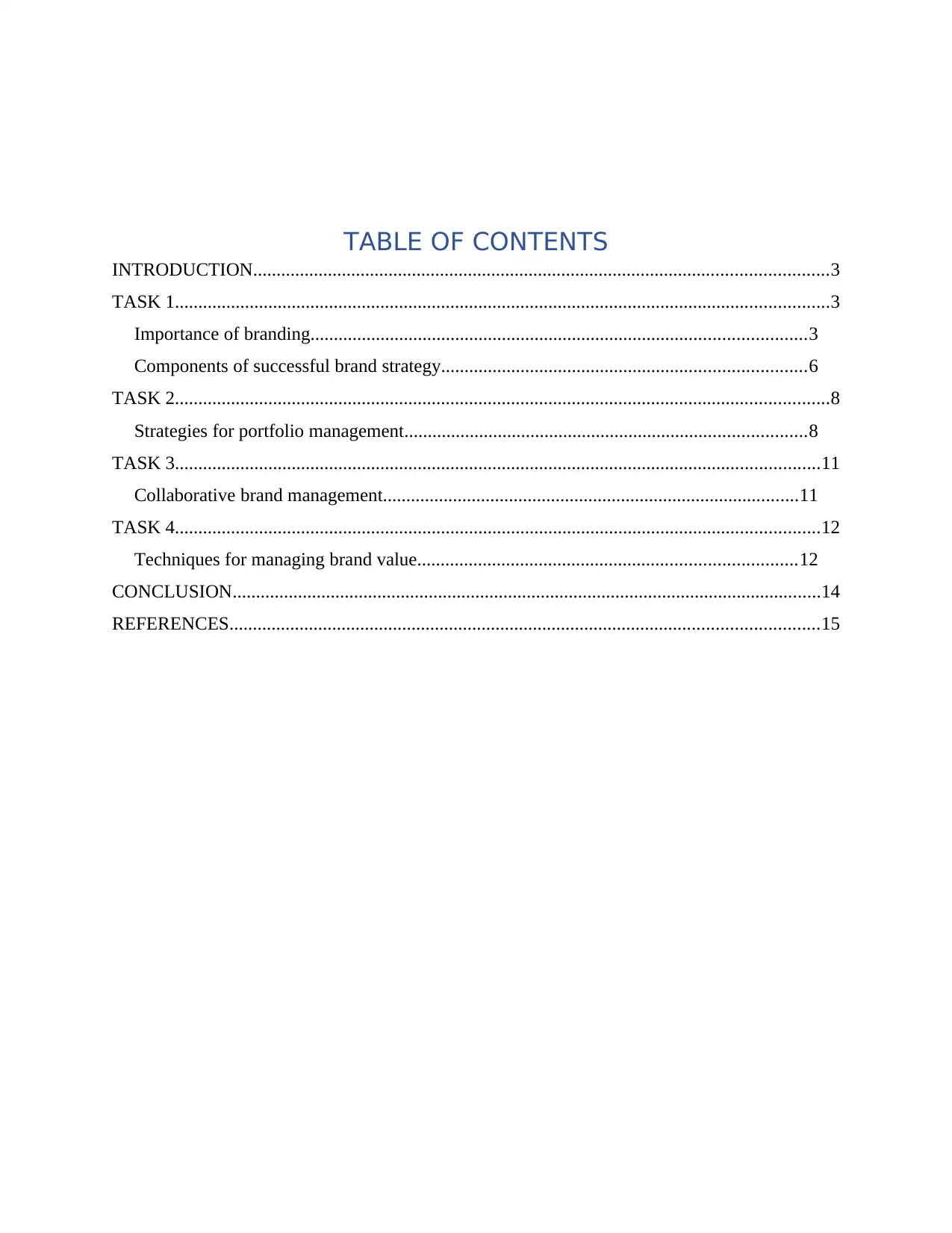
TABLE OF CONTENTS
INTRODUCTION...........................................................................................................................3
TASK 1............................................................................................................................................3
Importance of branding..........................................................................................................3
Components of successful brand strategy..............................................................................6
TASK 2............................................................................................................................................8
Strategies for portfolio management......................................................................................8
TASK 3..........................................................................................................................................11
Collaborative brand management.........................................................................................11
TASK 4..........................................................................................................................................12
Techniques for managing brand value.................................................................................12
CONCLUSION..............................................................................................................................14
REFERENCES..............................................................................................................................15
INTRODUCTION...........................................................................................................................3
TASK 1............................................................................................................................................3
Importance of branding..........................................................................................................3
Components of successful brand strategy..............................................................................6
TASK 2............................................................................................................................................8
Strategies for portfolio management......................................................................................8
TASK 3..........................................................................................................................................11
Collaborative brand management.........................................................................................11
TASK 4..........................................................................................................................................12
Techniques for managing brand value.................................................................................12
CONCLUSION..............................................................................................................................14
REFERENCES..............................................................................................................................15
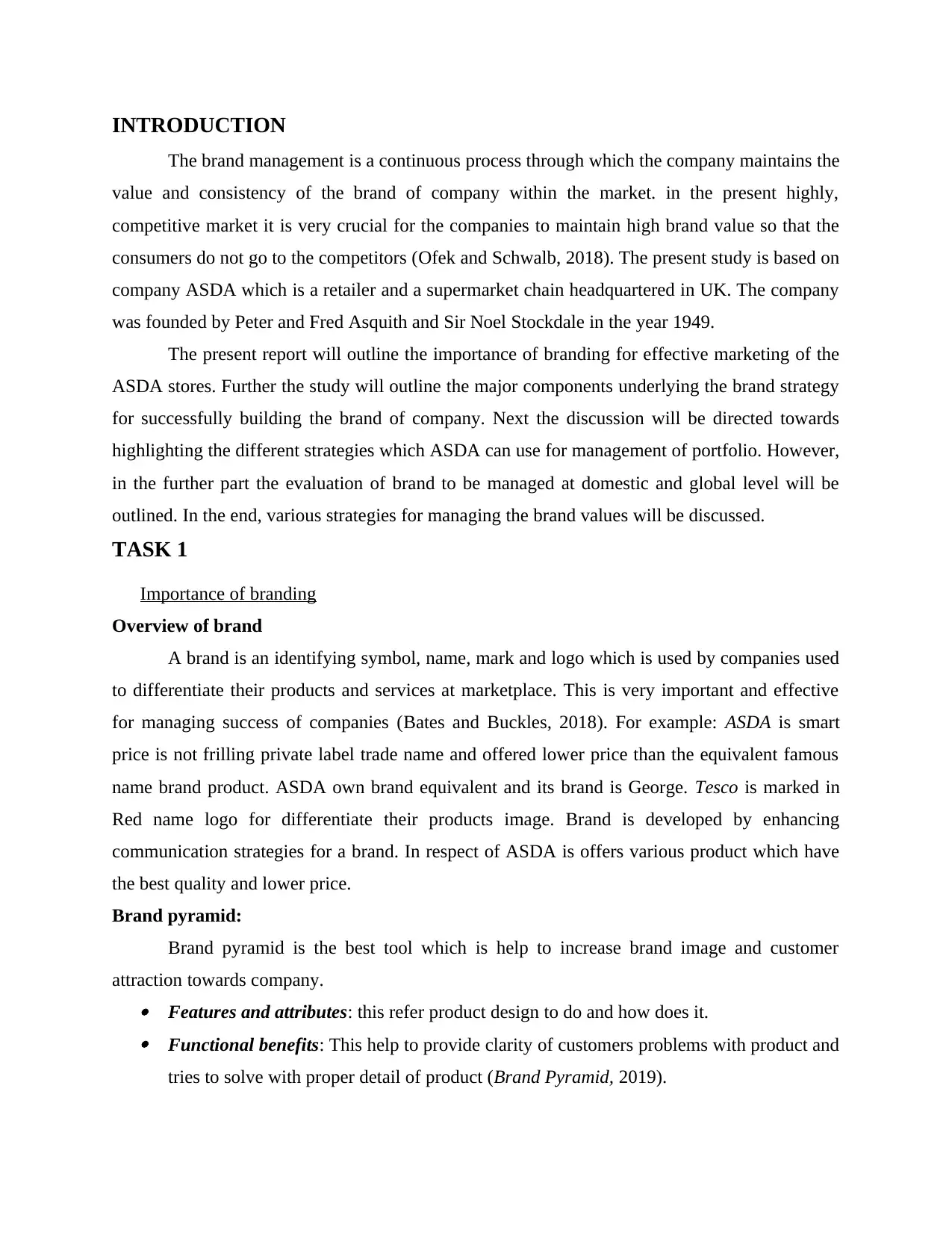
INTRODUCTION
The brand management is a continuous process through which the company maintains the
value and consistency of the brand of company within the market. in the present highly,
competitive market it is very crucial for the companies to maintain high brand value so that the
consumers do not go to the competitors (Ofek and Schwalb, 2018). The present study is based on
company ASDA which is a retailer and a supermarket chain headquartered in UK. The company
was founded by Peter and Fred Asquith and Sir Noel Stockdale in the year 1949.
The present report will outline the importance of branding for effective marketing of the
ASDA stores. Further the study will outline the major components underlying the brand strategy
for successfully building the brand of company. Next the discussion will be directed towards
highlighting the different strategies which ASDA can use for management of portfolio. However,
in the further part the evaluation of brand to be managed at domestic and global level will be
outlined. In the end, various strategies for managing the brand values will be discussed.
TASK 1
Importance of branding
Overview of brand
A brand is an identifying symbol, name, mark and logo which is used by companies used
to differentiate their products and services at marketplace. This is very important and effective
for managing success of companies (Bates and Buckles, 2018). For example: ASDA is smart
price is not frilling private label trade name and offered lower price than the equivalent famous
name brand product. ASDA own brand equivalent and its brand is George. Tesco is marked in
Red name logo for differentiate their products image. Brand is developed by enhancing
communication strategies for a brand. In respect of ASDA is offers various product which have
the best quality and lower price.
Brand pyramid:
Brand pyramid is the best tool which is help to increase brand image and customer
attraction towards company. Features and attributes: this refer product design to do and how does it. Functional benefits: This help to provide clarity of customers problems with product and
tries to solve with proper detail of product (Brand Pyramid, 2019).
The brand management is a continuous process through which the company maintains the
value and consistency of the brand of company within the market. in the present highly,
competitive market it is very crucial for the companies to maintain high brand value so that the
consumers do not go to the competitors (Ofek and Schwalb, 2018). The present study is based on
company ASDA which is a retailer and a supermarket chain headquartered in UK. The company
was founded by Peter and Fred Asquith and Sir Noel Stockdale in the year 1949.
The present report will outline the importance of branding for effective marketing of the
ASDA stores. Further the study will outline the major components underlying the brand strategy
for successfully building the brand of company. Next the discussion will be directed towards
highlighting the different strategies which ASDA can use for management of portfolio. However,
in the further part the evaluation of brand to be managed at domestic and global level will be
outlined. In the end, various strategies for managing the brand values will be discussed.
TASK 1
Importance of branding
Overview of brand
A brand is an identifying symbol, name, mark and logo which is used by companies used
to differentiate their products and services at marketplace. This is very important and effective
for managing success of companies (Bates and Buckles, 2018). For example: ASDA is smart
price is not frilling private label trade name and offered lower price than the equivalent famous
name brand product. ASDA own brand equivalent and its brand is George. Tesco is marked in
Red name logo for differentiate their products image. Brand is developed by enhancing
communication strategies for a brand. In respect of ASDA is offers various product which have
the best quality and lower price.
Brand pyramid:
Brand pyramid is the best tool which is help to increase brand image and customer
attraction towards company. Features and attributes: this refer product design to do and how does it. Functional benefits: This help to provide clarity of customers problems with product and
tries to solve with proper detail of product (Brand Pyramid, 2019).

Emotional benefits: This includes feelings of customers after using product and services
of company in effective manner. Brand or product personae: at this stage company need to introduce benefits of
particular product to customer and product development to customers to reinforce core
values (Oliva, 2018).
Brand idea: This essence or underlying the reason why customer purchase products. For
example: Apply brand essences is “empowering people through technology” and ASDA
brand essences is “becoming better retailer by providing the best quality of product and
services”.
Figure: Brand pyramid
(Source: Brand Pyramid, 2019)
Advantages of branding- branding is very advantageous for the companies as this help the
company in maintaining its brand within the market. The major advantages of branding are
discussed in the following points connected below-
Advantages for company- the major benefit of branding for the company is that this help
the company in standing out different from the other companies and competitors. The
of company in effective manner. Brand or product personae: at this stage company need to introduce benefits of
particular product to customer and product development to customers to reinforce core
values (Oliva, 2018).
Brand idea: This essence or underlying the reason why customer purchase products. For
example: Apply brand essences is “empowering people through technology” and ASDA
brand essences is “becoming better retailer by providing the best quality of product and
services”.
Figure: Brand pyramid
(Source: Brand Pyramid, 2019)
Advantages of branding- branding is very advantageous for the companies as this help the
company in maintaining its brand within the market. The major advantages of branding are
discussed in the following points connected below-
Advantages for company- the major benefit of branding for the company is that this help
the company in standing out different from the other companies and competitors. The
Paraphrase This Document
Need a fresh take? Get an instant paraphrase of this document with our AI Paraphraser
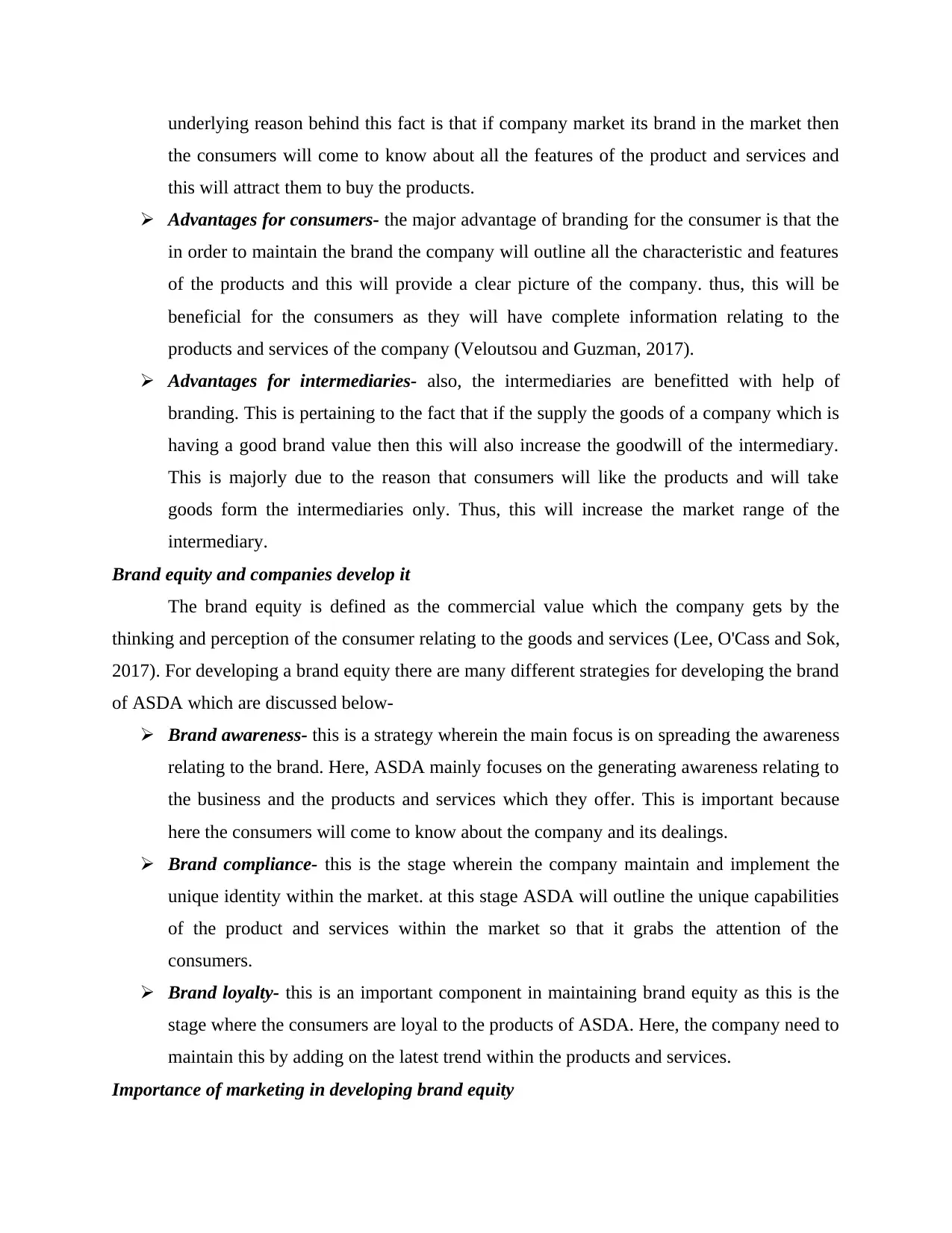
underlying reason behind this fact is that if company market its brand in the market then
the consumers will come to know about all the features of the product and services and
this will attract them to buy the products.
Advantages for consumers- the major advantage of branding for the consumer is that the
in order to maintain the brand the company will outline all the characteristic and features
of the products and this will provide a clear picture of the company. thus, this will be
beneficial for the consumers as they will have complete information relating to the
products and services of the company (Veloutsou and Guzman, 2017).
Advantages for intermediaries- also, the intermediaries are benefitted with help of
branding. This is pertaining to the fact that if the supply the goods of a company which is
having a good brand value then this will also increase the goodwill of the intermediary.
This is majorly due to the reason that consumers will like the products and will take
goods form the intermediaries only. Thus, this will increase the market range of the
intermediary.
Brand equity and companies develop it
The brand equity is defined as the commercial value which the company gets by the
thinking and perception of the consumer relating to the goods and services (Lee, O'Cass and Sok,
2017). For developing a brand equity there are many different strategies for developing the brand
of ASDA which are discussed below-
Brand awareness- this is a strategy wherein the main focus is on spreading the awareness
relating to the brand. Here, ASDA mainly focuses on the generating awareness relating to
the business and the products and services which they offer. This is important because
here the consumers will come to know about the company and its dealings.
Brand compliance- this is the stage wherein the company maintain and implement the
unique identity within the market. at this stage ASDA will outline the unique capabilities
of the product and services within the market so that it grabs the attention of the
consumers.
Brand loyalty- this is an important component in maintaining brand equity as this is the
stage where the consumers are loyal to the products of ASDA. Here, the company need to
maintain this by adding on the latest trend within the products and services.
Importance of marketing in developing brand equity
the consumers will come to know about all the features of the product and services and
this will attract them to buy the products.
Advantages for consumers- the major advantage of branding for the consumer is that the
in order to maintain the brand the company will outline all the characteristic and features
of the products and this will provide a clear picture of the company. thus, this will be
beneficial for the consumers as they will have complete information relating to the
products and services of the company (Veloutsou and Guzman, 2017).
Advantages for intermediaries- also, the intermediaries are benefitted with help of
branding. This is pertaining to the fact that if the supply the goods of a company which is
having a good brand value then this will also increase the goodwill of the intermediary.
This is majorly due to the reason that consumers will like the products and will take
goods form the intermediaries only. Thus, this will increase the market range of the
intermediary.
Brand equity and companies develop it
The brand equity is defined as the commercial value which the company gets by the
thinking and perception of the consumer relating to the goods and services (Lee, O'Cass and Sok,
2017). For developing a brand equity there are many different strategies for developing the brand
of ASDA which are discussed below-
Brand awareness- this is a strategy wherein the main focus is on spreading the awareness
relating to the brand. Here, ASDA mainly focuses on the generating awareness relating to
the business and the products and services which they offer. This is important because
here the consumers will come to know about the company and its dealings.
Brand compliance- this is the stage wherein the company maintain and implement the
unique identity within the market. at this stage ASDA will outline the unique capabilities
of the product and services within the market so that it grabs the attention of the
consumers.
Brand loyalty- this is an important component in maintaining brand equity as this is the
stage where the consumers are loyal to the products of ASDA. Here, the company need to
maintain this by adding on the latest trend within the products and services.
Importance of marketing in developing brand equity
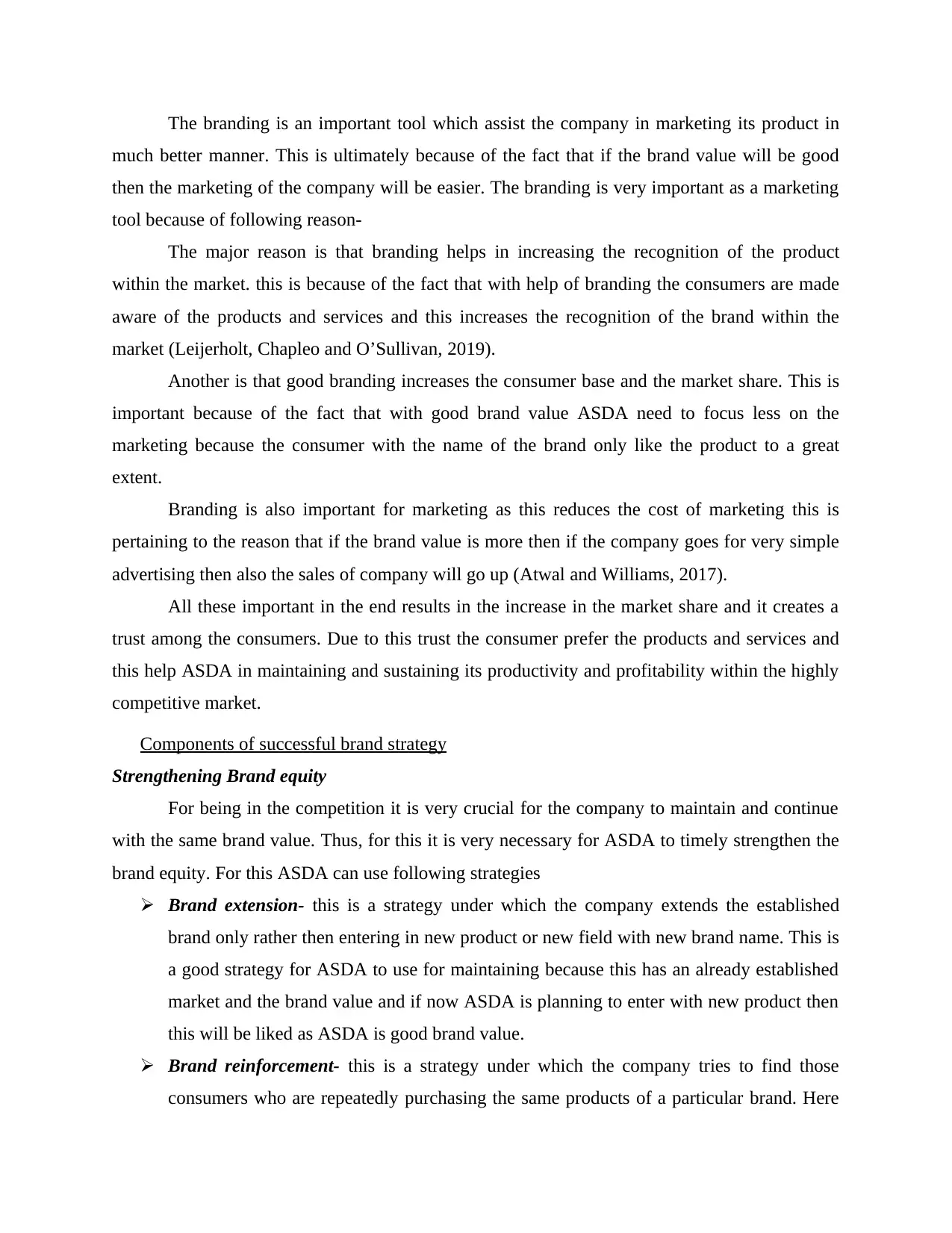
The branding is an important tool which assist the company in marketing its product in
much better manner. This is ultimately because of the fact that if the brand value will be good
then the marketing of the company will be easier. The branding is very important as a marketing
tool because of following reason-
The major reason is that branding helps in increasing the recognition of the product
within the market. this is because of the fact that with help of branding the consumers are made
aware of the products and services and this increases the recognition of the brand within the
market (Leijerholt, Chapleo and O’Sullivan, 2019).
Another is that good branding increases the consumer base and the market share. This is
important because of the fact that with good brand value ASDA need to focus less on the
marketing because the consumer with the name of the brand only like the product to a great
extent.
Branding is also important for marketing as this reduces the cost of marketing this is
pertaining to the reason that if the brand value is more then if the company goes for very simple
advertising then also the sales of company will go up (Atwal and Williams, 2017).
All these important in the end results in the increase in the market share and it creates a
trust among the consumers. Due to this trust the consumer prefer the products and services and
this help ASDA in maintaining and sustaining its productivity and profitability within the highly
competitive market.
Components of successful brand strategy
Strengthening Brand equity
For being in the competition it is very crucial for the company to maintain and continue
with the same brand value. Thus, for this it is very necessary for ASDA to timely strengthen the
brand equity. For this ASDA can use following strategies
Brand extension- this is a strategy under which the company extends the established
brand only rather then entering in new product or new field with new brand name. This is
a good strategy for ASDA to use for maintaining because this has an already established
market and the brand value and if now ASDA is planning to enter with new product then
this will be liked as ASDA is good brand value.
Brand reinforcement- this is a strategy under which the company tries to find those
consumers who are repeatedly purchasing the same products of a particular brand. Here
much better manner. This is ultimately because of the fact that if the brand value will be good
then the marketing of the company will be easier. The branding is very important as a marketing
tool because of following reason-
The major reason is that branding helps in increasing the recognition of the product
within the market. this is because of the fact that with help of branding the consumers are made
aware of the products and services and this increases the recognition of the brand within the
market (Leijerholt, Chapleo and O’Sullivan, 2019).
Another is that good branding increases the consumer base and the market share. This is
important because of the fact that with good brand value ASDA need to focus less on the
marketing because the consumer with the name of the brand only like the product to a great
extent.
Branding is also important for marketing as this reduces the cost of marketing this is
pertaining to the reason that if the brand value is more then if the company goes for very simple
advertising then also the sales of company will go up (Atwal and Williams, 2017).
All these important in the end results in the increase in the market share and it creates a
trust among the consumers. Due to this trust the consumer prefer the products and services and
this help ASDA in maintaining and sustaining its productivity and profitability within the highly
competitive market.
Components of successful brand strategy
Strengthening Brand equity
For being in the competition it is very crucial for the company to maintain and continue
with the same brand value. Thus, for this it is very necessary for ASDA to timely strengthen the
brand equity. For this ASDA can use following strategies
Brand extension- this is a strategy under which the company extends the established
brand only rather then entering in new product or new field with new brand name. This is
a good strategy for ASDA to use for maintaining because this has an already established
market and the brand value and if now ASDA is planning to enter with new product then
this will be liked as ASDA is good brand value.
Brand reinforcement- this is a strategy under which the company tries to find those
consumers who are repeatedly purchasing the same products of a particular brand. Here
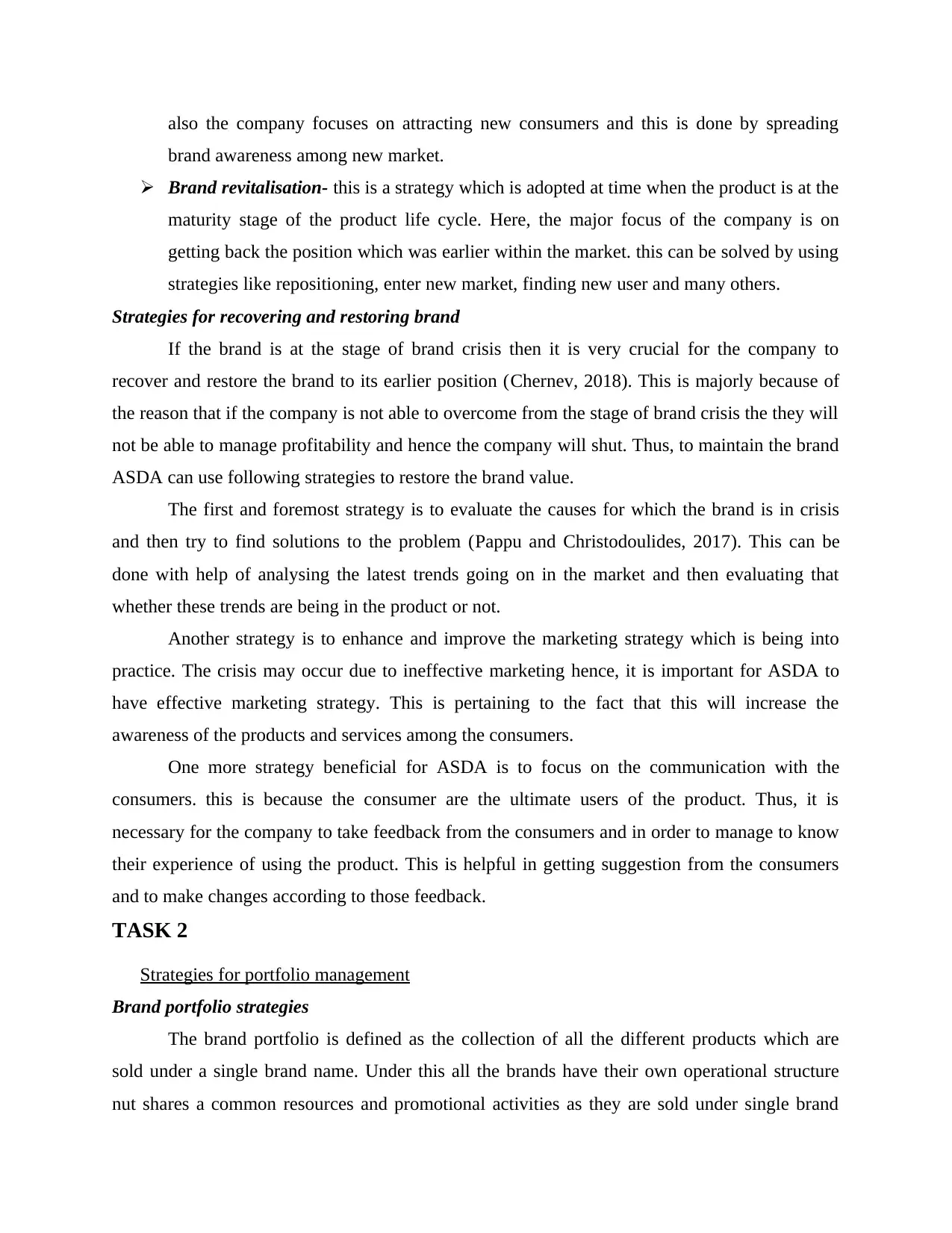
also the company focuses on attracting new consumers and this is done by spreading
brand awareness among new market.
Brand revitalisation- this is a strategy which is adopted at time when the product is at the
maturity stage of the product life cycle. Here, the major focus of the company is on
getting back the position which was earlier within the market. this can be solved by using
strategies like repositioning, enter new market, finding new user and many others.
Strategies for recovering and restoring brand
If the brand is at the stage of brand crisis then it is very crucial for the company to
recover and restore the brand to its earlier position (Chernev, 2018). This is majorly because of
the reason that if the company is not able to overcome from the stage of brand crisis the they will
not be able to manage profitability and hence the company will shut. Thus, to maintain the brand
ASDA can use following strategies to restore the brand value.
The first and foremost strategy is to evaluate the causes for which the brand is in crisis
and then try to find solutions to the problem (Pappu and Christodoulides, 2017). This can be
done with help of analysing the latest trends going on in the market and then evaluating that
whether these trends are being in the product or not.
Another strategy is to enhance and improve the marketing strategy which is being into
practice. The crisis may occur due to ineffective marketing hence, it is important for ASDA to
have effective marketing strategy. This is pertaining to the fact that this will increase the
awareness of the products and services among the consumers.
One more strategy beneficial for ASDA is to focus on the communication with the
consumers. this is because the consumer are the ultimate users of the product. Thus, it is
necessary for the company to take feedback from the consumers and in order to manage to know
their experience of using the product. This is helpful in getting suggestion from the consumers
and to make changes according to those feedback.
TASK 2
Strategies for portfolio management
Brand portfolio strategies
The brand portfolio is defined as the collection of all the different products which are
sold under a single brand name. Under this all the brands have their own operational structure
nut shares a common resources and promotional activities as they are sold under single brand
brand awareness among new market.
Brand revitalisation- this is a strategy which is adopted at time when the product is at the
maturity stage of the product life cycle. Here, the major focus of the company is on
getting back the position which was earlier within the market. this can be solved by using
strategies like repositioning, enter new market, finding new user and many others.
Strategies for recovering and restoring brand
If the brand is at the stage of brand crisis then it is very crucial for the company to
recover and restore the brand to its earlier position (Chernev, 2018). This is majorly because of
the reason that if the company is not able to overcome from the stage of brand crisis the they will
not be able to manage profitability and hence the company will shut. Thus, to maintain the brand
ASDA can use following strategies to restore the brand value.
The first and foremost strategy is to evaluate the causes for which the brand is in crisis
and then try to find solutions to the problem (Pappu and Christodoulides, 2017). This can be
done with help of analysing the latest trends going on in the market and then evaluating that
whether these trends are being in the product or not.
Another strategy is to enhance and improve the marketing strategy which is being into
practice. The crisis may occur due to ineffective marketing hence, it is important for ASDA to
have effective marketing strategy. This is pertaining to the fact that this will increase the
awareness of the products and services among the consumers.
One more strategy beneficial for ASDA is to focus on the communication with the
consumers. this is because the consumer are the ultimate users of the product. Thus, it is
necessary for the company to take feedback from the consumers and in order to manage to know
their experience of using the product. This is helpful in getting suggestion from the consumers
and to make changes according to those feedback.
TASK 2
Strategies for portfolio management
Brand portfolio strategies
The brand portfolio is defined as the collection of all the different products which are
sold under a single brand name. Under this all the brands have their own operational structure
nut shares a common resources and promotional activities as they are sold under single brand
Secure Best Marks with AI Grader
Need help grading? Try our AI Grader for instant feedback on your assignments.
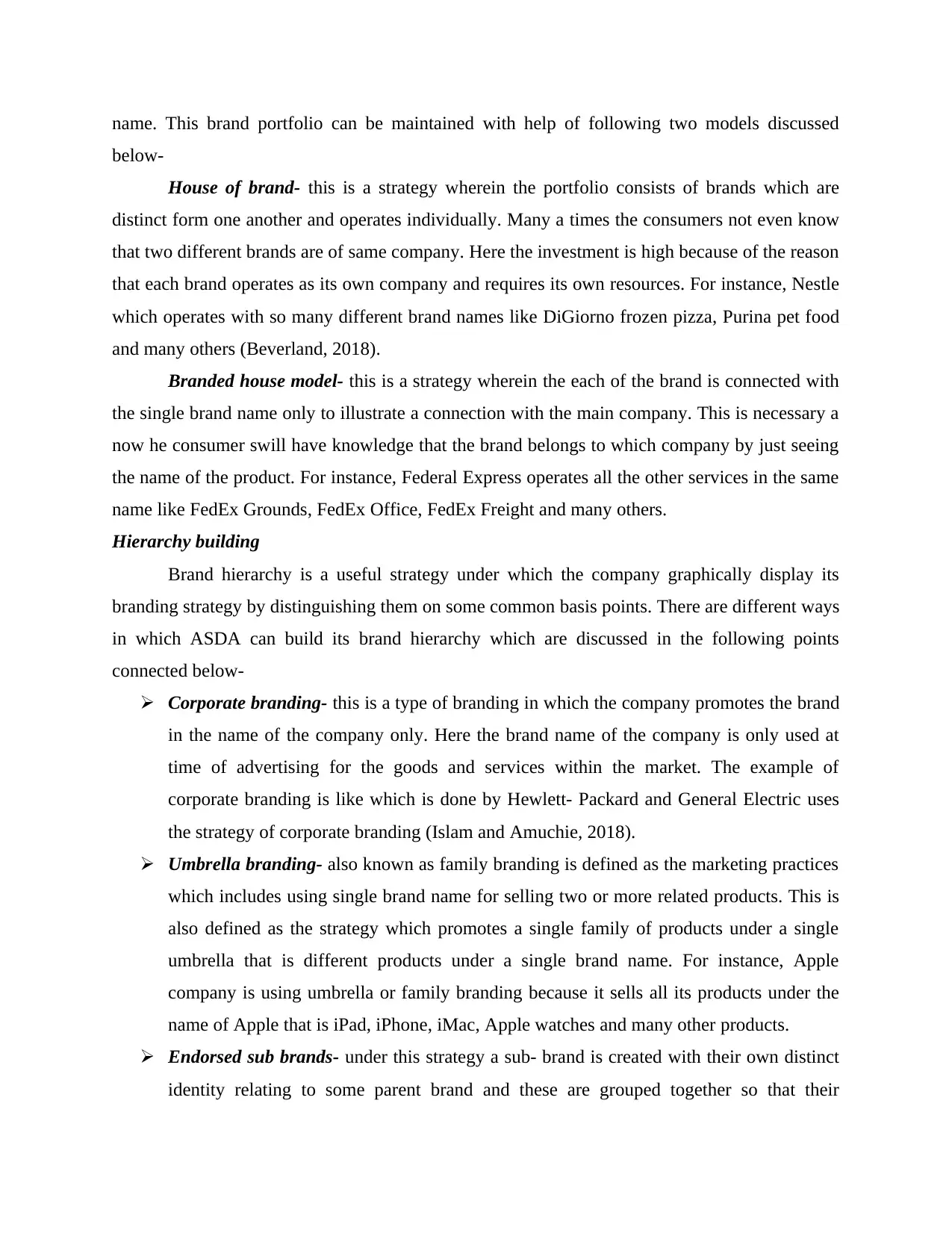
name. This brand portfolio can be maintained with help of following two models discussed
below-
House of brand- this is a strategy wherein the portfolio consists of brands which are
distinct form one another and operates individually. Many a times the consumers not even know
that two different brands are of same company. Here the investment is high because of the reason
that each brand operates as its own company and requires its own resources. For instance, Nestle
which operates with so many different brand names like DiGiorno frozen pizza, Purina pet food
and many others (Beverland, 2018).
Branded house model- this is a strategy wherein the each of the brand is connected with
the single brand name only to illustrate a connection with the main company. This is necessary a
now he consumer swill have knowledge that the brand belongs to which company by just seeing
the name of the product. For instance, Federal Express operates all the other services in the same
name like FedEx Grounds, FedEx Office, FedEx Freight and many others.
Hierarchy building
Brand hierarchy is a useful strategy under which the company graphically display its
branding strategy by distinguishing them on some common basis points. There are different ways
in which ASDA can build its brand hierarchy which are discussed in the following points
connected below-
Corporate branding- this is a type of branding in which the company promotes the brand
in the name of the company only. Here the brand name of the company is only used at
time of advertising for the goods and services within the market. The example of
corporate branding is like which is done by Hewlett- Packard and General Electric uses
the strategy of corporate branding (Islam and Amuchie, 2018).
Umbrella branding- also known as family branding is defined as the marketing practices
which includes using single brand name for selling two or more related products. This is
also defined as the strategy which promotes a single family of products under a single
umbrella that is different products under a single brand name. For instance, Apple
company is using umbrella or family branding because it sells all its products under the
name of Apple that is iPad, iPhone, iMac, Apple watches and many other products.
Endorsed sub brands- under this strategy a sub- brand is created with their own distinct
identity relating to some parent brand and these are grouped together so that their
below-
House of brand- this is a strategy wherein the portfolio consists of brands which are
distinct form one another and operates individually. Many a times the consumers not even know
that two different brands are of same company. Here the investment is high because of the reason
that each brand operates as its own company and requires its own resources. For instance, Nestle
which operates with so many different brand names like DiGiorno frozen pizza, Purina pet food
and many others (Beverland, 2018).
Branded house model- this is a strategy wherein the each of the brand is connected with
the single brand name only to illustrate a connection with the main company. This is necessary a
now he consumer swill have knowledge that the brand belongs to which company by just seeing
the name of the product. For instance, Federal Express operates all the other services in the same
name like FedEx Grounds, FedEx Office, FedEx Freight and many others.
Hierarchy building
Brand hierarchy is a useful strategy under which the company graphically display its
branding strategy by distinguishing them on some common basis points. There are different ways
in which ASDA can build its brand hierarchy which are discussed in the following points
connected below-
Corporate branding- this is a type of branding in which the company promotes the brand
in the name of the company only. Here the brand name of the company is only used at
time of advertising for the goods and services within the market. The example of
corporate branding is like which is done by Hewlett- Packard and General Electric uses
the strategy of corporate branding (Islam and Amuchie, 2018).
Umbrella branding- also known as family branding is defined as the marketing practices
which includes using single brand name for selling two or more related products. This is
also defined as the strategy which promotes a single family of products under a single
umbrella that is different products under a single brand name. For instance, Apple
company is using umbrella or family branding because it sells all its products under the
name of Apple that is iPad, iPhone, iMac, Apple watches and many other products.
Endorsed sub brands- under this strategy a sub- brand is created with their own distinct
identity relating to some parent brand and these are grouped together so that their
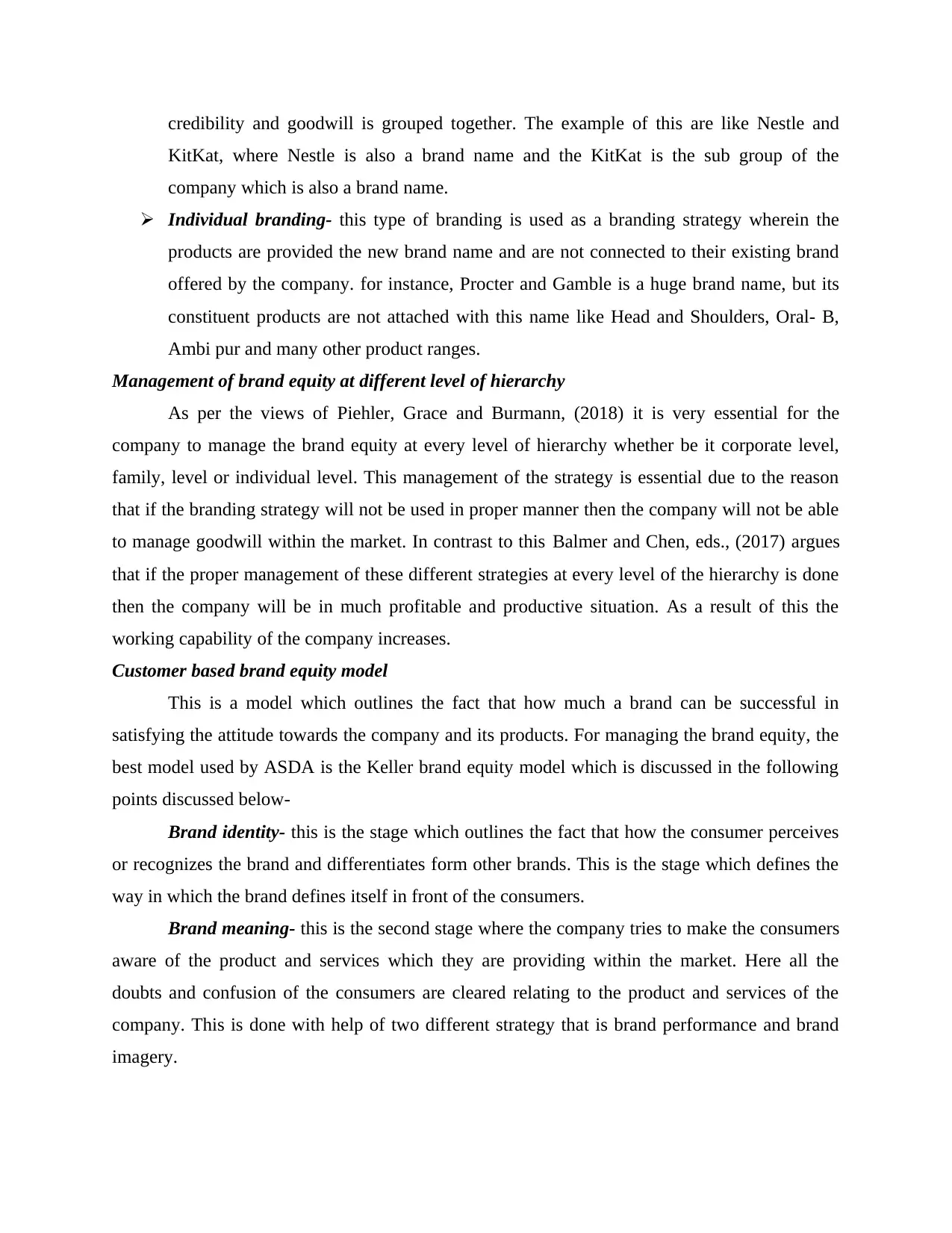
credibility and goodwill is grouped together. The example of this are like Nestle and
KitKat, where Nestle is also a brand name and the KitKat is the sub group of the
company which is also a brand name.
Individual branding- this type of branding is used as a branding strategy wherein the
products are provided the new brand name and are not connected to their existing brand
offered by the company. for instance, Procter and Gamble is a huge brand name, but its
constituent products are not attached with this name like Head and Shoulders, Oral- B,
Ambi pur and many other product ranges.
Management of brand equity at different level of hierarchy
As per the views of Piehler, Grace and Burmann, (2018) it is very essential for the
company to manage the brand equity at every level of hierarchy whether be it corporate level,
family, level or individual level. This management of the strategy is essential due to the reason
that if the branding strategy will not be used in proper manner then the company will not be able
to manage goodwill within the market. In contrast to this Balmer and Chen, eds., (2017) argues
that if the proper management of these different strategies at every level of the hierarchy is done
then the company will be in much profitable and productive situation. As a result of this the
working capability of the company increases.
Customer based brand equity model
This is a model which outlines the fact that how much a brand can be successful in
satisfying the attitude towards the company and its products. For managing the brand equity, the
best model used by ASDA is the Keller brand equity model which is discussed in the following
points discussed below-
Brand identity- this is the stage which outlines the fact that how the consumer perceives
or recognizes the brand and differentiates form other brands. This is the stage which defines the
way in which the brand defines itself in front of the consumers.
Brand meaning- this is the second stage where the company tries to make the consumers
aware of the product and services which they are providing within the market. Here all the
doubts and confusion of the consumers are cleared relating to the product and services of the
company. This is done with help of two different strategy that is brand performance and brand
imagery.
KitKat, where Nestle is also a brand name and the KitKat is the sub group of the
company which is also a brand name.
Individual branding- this type of branding is used as a branding strategy wherein the
products are provided the new brand name and are not connected to their existing brand
offered by the company. for instance, Procter and Gamble is a huge brand name, but its
constituent products are not attached with this name like Head and Shoulders, Oral- B,
Ambi pur and many other product ranges.
Management of brand equity at different level of hierarchy
As per the views of Piehler, Grace and Burmann, (2018) it is very essential for the
company to manage the brand equity at every level of hierarchy whether be it corporate level,
family, level or individual level. This management of the strategy is essential due to the reason
that if the branding strategy will not be used in proper manner then the company will not be able
to manage goodwill within the market. In contrast to this Balmer and Chen, eds., (2017) argues
that if the proper management of these different strategies at every level of the hierarchy is done
then the company will be in much profitable and productive situation. As a result of this the
working capability of the company increases.
Customer based brand equity model
This is a model which outlines the fact that how much a brand can be successful in
satisfying the attitude towards the company and its products. For managing the brand equity, the
best model used by ASDA is the Keller brand equity model which is discussed in the following
points discussed below-
Brand identity- this is the stage which outlines the fact that how the consumer perceives
or recognizes the brand and differentiates form other brands. This is the stage which defines the
way in which the brand defines itself in front of the consumers.
Brand meaning- this is the second stage where the company tries to make the consumers
aware of the product and services which they are providing within the market. Here all the
doubts and confusion of the consumers are cleared relating to the product and services of the
company. This is done with help of two different strategy that is brand performance and brand
imagery.
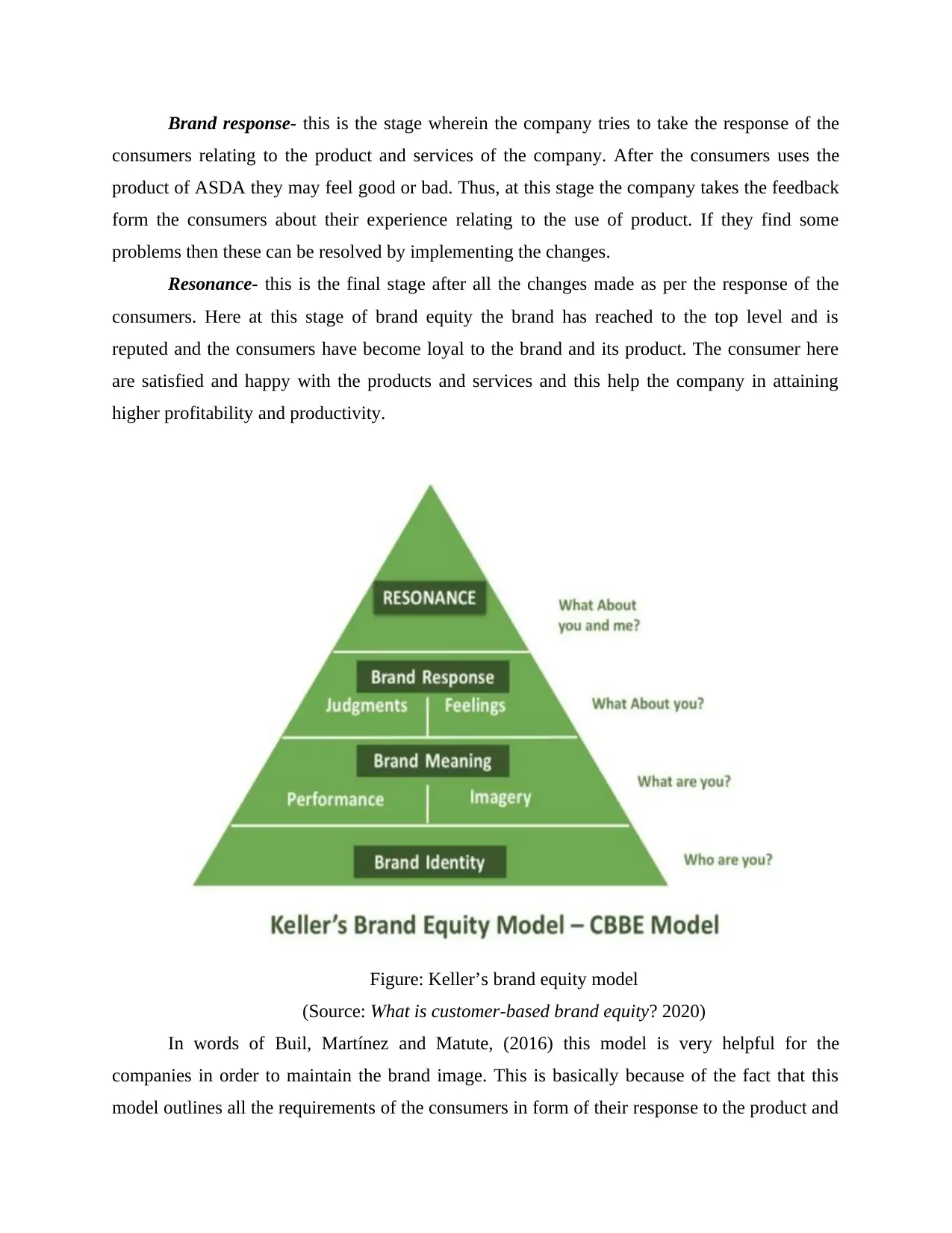
Brand response- this is the stage wherein the company tries to take the response of the
consumers relating to the product and services of the company. After the consumers uses the
product of ASDA they may feel good or bad. Thus, at this stage the company takes the feedback
form the consumers about their experience relating to the use of product. If they find some
problems then these can be resolved by implementing the changes.
Resonance- this is the final stage after all the changes made as per the response of the
consumers. Here at this stage of brand equity the brand has reached to the top level and is
reputed and the consumers have become loyal to the brand and its product. The consumer here
are satisfied and happy with the products and services and this help the company in attaining
higher profitability and productivity.
Figure: Keller’s brand equity model
(Source: What is customer-based brand equity? 2020)
In words of Buil, Martínez and Matute, (2016) this model is very helpful for the
companies in order to maintain the brand image. This is basically because of the fact that this
model outlines all the requirements of the consumers in form of their response to the product and
consumers relating to the product and services of the company. After the consumers uses the
product of ASDA they may feel good or bad. Thus, at this stage the company takes the feedback
form the consumers about their experience relating to the use of product. If they find some
problems then these can be resolved by implementing the changes.
Resonance- this is the final stage after all the changes made as per the response of the
consumers. Here at this stage of brand equity the brand has reached to the top level and is
reputed and the consumers have become loyal to the brand and its product. The consumer here
are satisfied and happy with the products and services and this help the company in attaining
higher profitability and productivity.
Figure: Keller’s brand equity model
(Source: What is customer-based brand equity? 2020)
In words of Buil, Martínez and Matute, (2016) this model is very helpful for the
companies in order to maintain the brand image. This is basically because of the fact that this
model outlines all the requirements of the consumers in form of their response to the product and
Paraphrase This Document
Need a fresh take? Get an instant paraphrase of this document with our AI Paraphraser
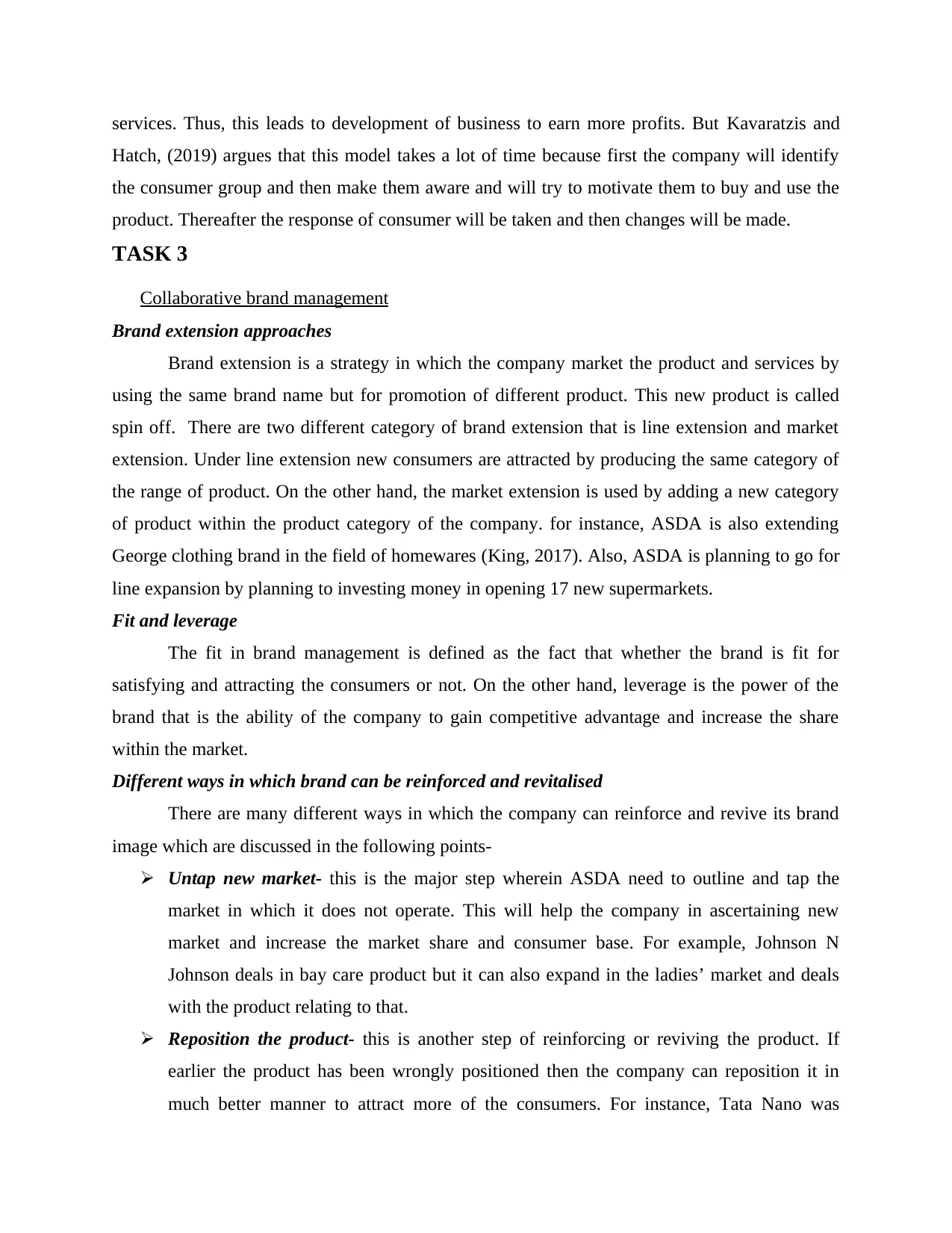
services. Thus, this leads to development of business to earn more profits. But Kavaratzis and
Hatch, (2019) argues that this model takes a lot of time because first the company will identify
the consumer group and then make them aware and will try to motivate them to buy and use the
product. Thereafter the response of consumer will be taken and then changes will be made.
TASK 3
Collaborative brand management
Brand extension approaches
Brand extension is a strategy in which the company market the product and services by
using the same brand name but for promotion of different product. This new product is called
spin off. There are two different category of brand extension that is line extension and market
extension. Under line extension new consumers are attracted by producing the same category of
the range of product. On the other hand, the market extension is used by adding a new category
of product within the product category of the company. for instance, ASDA is also extending
George clothing brand in the field of homewares (King, 2017). Also, ASDA is planning to go for
line expansion by planning to investing money in opening 17 new supermarkets.
Fit and leverage
The fit in brand management is defined as the fact that whether the brand is fit for
satisfying and attracting the consumers or not. On the other hand, leverage is the power of the
brand that is the ability of the company to gain competitive advantage and increase the share
within the market.
Different ways in which brand can be reinforced and revitalised
There are many different ways in which the company can reinforce and revive its brand
image which are discussed in the following points-
Untap new market- this is the major step wherein ASDA need to outline and tap the
market in which it does not operate. This will help the company in ascertaining new
market and increase the market share and consumer base. For example, Johnson N
Johnson deals in bay care product but it can also expand in the ladies’ market and deals
with the product relating to that.
Reposition the product- this is another step of reinforcing or reviving the product. If
earlier the product has been wrongly positioned then the company can reposition it in
much better manner to attract more of the consumers. For instance, Tata Nano was
Hatch, (2019) argues that this model takes a lot of time because first the company will identify
the consumer group and then make them aware and will try to motivate them to buy and use the
product. Thereafter the response of consumer will be taken and then changes will be made.
TASK 3
Collaborative brand management
Brand extension approaches
Brand extension is a strategy in which the company market the product and services by
using the same brand name but for promotion of different product. This new product is called
spin off. There are two different category of brand extension that is line extension and market
extension. Under line extension new consumers are attracted by producing the same category of
the range of product. On the other hand, the market extension is used by adding a new category
of product within the product category of the company. for instance, ASDA is also extending
George clothing brand in the field of homewares (King, 2017). Also, ASDA is planning to go for
line expansion by planning to investing money in opening 17 new supermarkets.
Fit and leverage
The fit in brand management is defined as the fact that whether the brand is fit for
satisfying and attracting the consumers or not. On the other hand, leverage is the power of the
brand that is the ability of the company to gain competitive advantage and increase the share
within the market.
Different ways in which brand can be reinforced and revitalised
There are many different ways in which the company can reinforce and revive its brand
image which are discussed in the following points-
Untap new market- this is the major step wherein ASDA need to outline and tap the
market in which it does not operate. This will help the company in ascertaining new
market and increase the market share and consumer base. For example, Johnson N
Johnson deals in bay care product but it can also expand in the ladies’ market and deals
with the product relating to that.
Reposition the product- this is another step of reinforcing or reviving the product. If
earlier the product has been wrongly positioned then the company can reposition it in
much better manner to attract more of the consumers. For instance, Tata Nano was
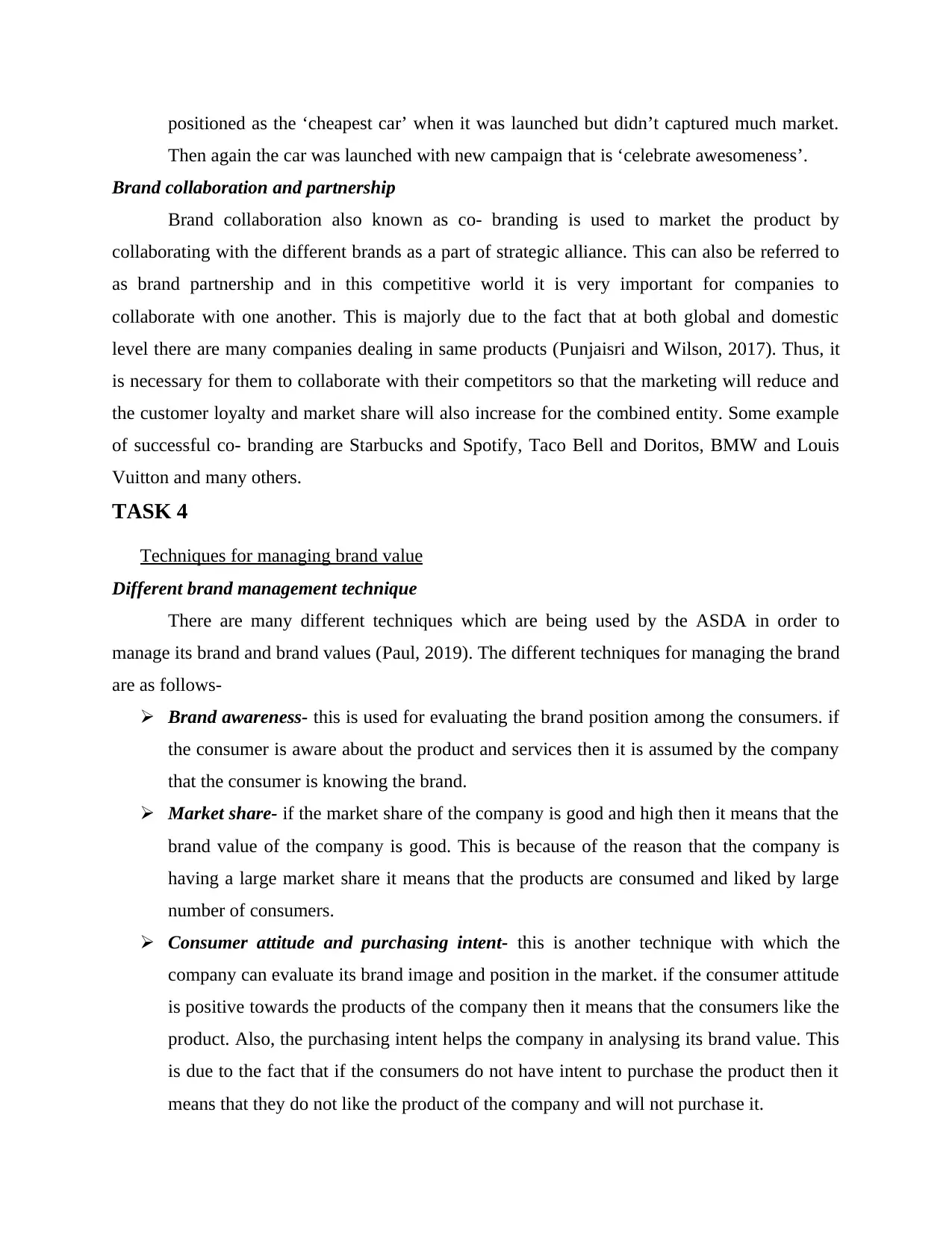
positioned as the ‘cheapest car’ when it was launched but didn’t captured much market.
Then again the car was launched with new campaign that is ‘celebrate awesomeness’.
Brand collaboration and partnership
Brand collaboration also known as co- branding is used to market the product by
collaborating with the different brands as a part of strategic alliance. This can also be referred to
as brand partnership and in this competitive world it is very important for companies to
collaborate with one another. This is majorly due to the fact that at both global and domestic
level there are many companies dealing in same products (Punjaisri and Wilson, 2017). Thus, it
is necessary for them to collaborate with their competitors so that the marketing will reduce and
the customer loyalty and market share will also increase for the combined entity. Some example
of successful co- branding are Starbucks and Spotify, Taco Bell and Doritos, BMW and Louis
Vuitton and many others.
TASK 4
Techniques for managing brand value
Different brand management technique
There are many different techniques which are being used by the ASDA in order to
manage its brand and brand values (Paul, 2019). The different techniques for managing the brand
are as follows-
Brand awareness- this is used for evaluating the brand position among the consumers. if
the consumer is aware about the product and services then it is assumed by the company
that the consumer is knowing the brand.
Market share- if the market share of the company is good and high then it means that the
brand value of the company is good. This is because of the reason that the company is
having a large market share it means that the products are consumed and liked by large
number of consumers.
Consumer attitude and purchasing intent- this is another technique with which the
company can evaluate its brand image and position in the market. if the consumer attitude
is positive towards the products of the company then it means that the consumers like the
product. Also, the purchasing intent helps the company in analysing its brand value. This
is due to the fact that if the consumers do not have intent to purchase the product then it
means that they do not like the product of the company and will not purchase it.
Then again the car was launched with new campaign that is ‘celebrate awesomeness’.
Brand collaboration and partnership
Brand collaboration also known as co- branding is used to market the product by
collaborating with the different brands as a part of strategic alliance. This can also be referred to
as brand partnership and in this competitive world it is very important for companies to
collaborate with one another. This is majorly due to the fact that at both global and domestic
level there are many companies dealing in same products (Punjaisri and Wilson, 2017). Thus, it
is necessary for them to collaborate with their competitors so that the marketing will reduce and
the customer loyalty and market share will also increase for the combined entity. Some example
of successful co- branding are Starbucks and Spotify, Taco Bell and Doritos, BMW and Louis
Vuitton and many others.
TASK 4
Techniques for managing brand value
Different brand management technique
There are many different techniques which are being used by the ASDA in order to
manage its brand and brand values (Paul, 2019). The different techniques for managing the brand
are as follows-
Brand awareness- this is used for evaluating the brand position among the consumers. if
the consumer is aware about the product and services then it is assumed by the company
that the consumer is knowing the brand.
Market share- if the market share of the company is good and high then it means that the
brand value of the company is good. This is because of the reason that the company is
having a large market share it means that the products are consumed and liked by large
number of consumers.
Consumer attitude and purchasing intent- this is another technique with which the
company can evaluate its brand image and position in the market. if the consumer attitude
is positive towards the products of the company then it means that the consumers like the
product. Also, the purchasing intent helps the company in analysing its brand value. This
is due to the fact that if the consumers do not have intent to purchase the product then it
means that they do not like the product of the company and will not purchase it.
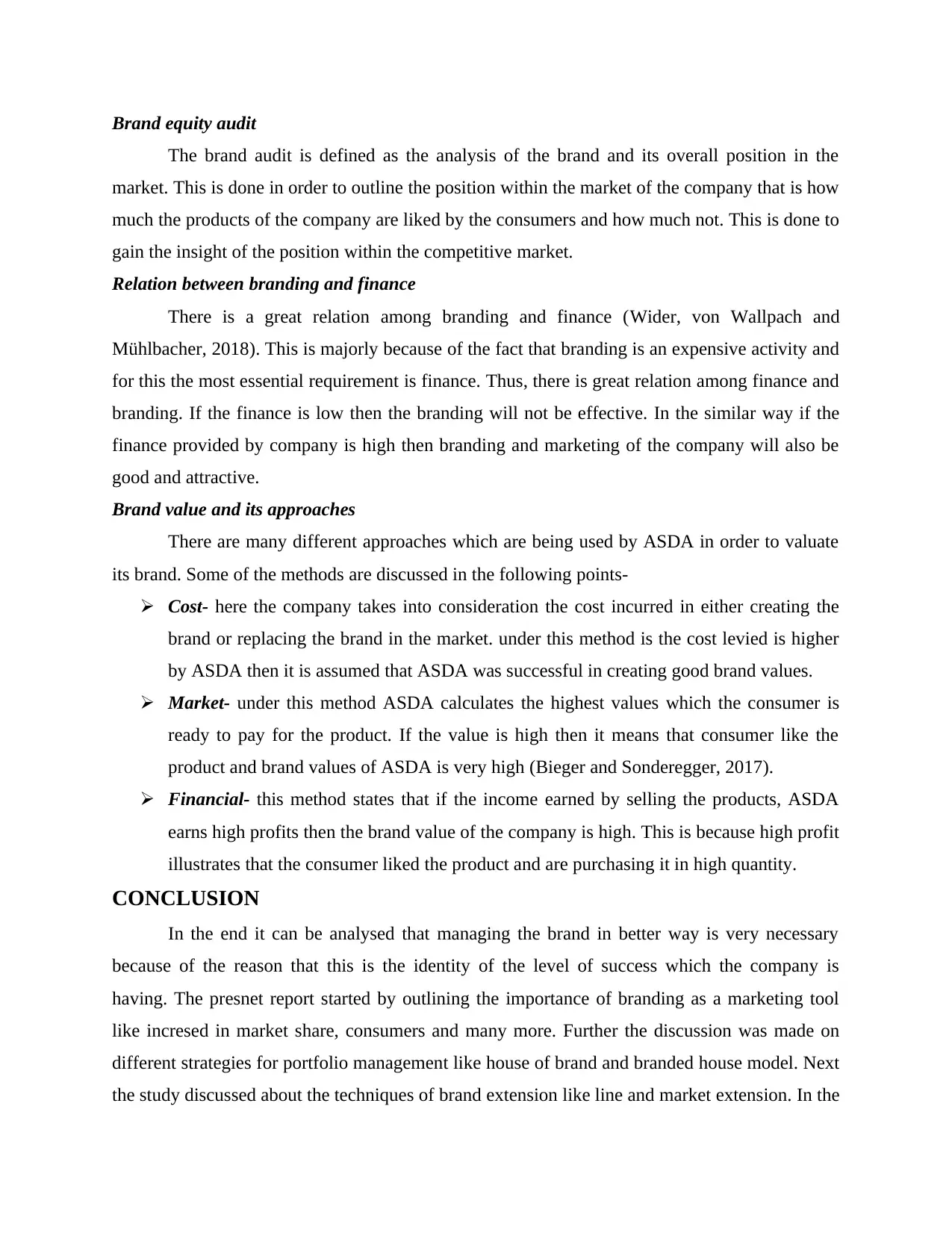
Brand equity audit
The brand audit is defined as the analysis of the brand and its overall position in the
market. This is done in order to outline the position within the market of the company that is how
much the products of the company are liked by the consumers and how much not. This is done to
gain the insight of the position within the competitive market.
Relation between branding and finance
There is a great relation among branding and finance (Wider, von Wallpach and
Mühlbacher, 2018). This is majorly because of the fact that branding is an expensive activity and
for this the most essential requirement is finance. Thus, there is great relation among finance and
branding. If the finance is low then the branding will not be effective. In the similar way if the
finance provided by company is high then branding and marketing of the company will also be
good and attractive.
Brand value and its approaches
There are many different approaches which are being used by ASDA in order to valuate
its brand. Some of the methods are discussed in the following points-
Cost- here the company takes into consideration the cost incurred in either creating the
brand or replacing the brand in the market. under this method is the cost levied is higher
by ASDA then it is assumed that ASDA was successful in creating good brand values.
Market- under this method ASDA calculates the highest values which the consumer is
ready to pay for the product. If the value is high then it means that consumer like the
product and brand values of ASDA is very high (Bieger and Sonderegger, 2017).
Financial- this method states that if the income earned by selling the products, ASDA
earns high profits then the brand value of the company is high. This is because high profit
illustrates that the consumer liked the product and are purchasing it in high quantity.
CONCLUSION
In the end it can be analysed that managing the brand in better way is very necessary
because of the reason that this is the identity of the level of success which the company is
having. The presnet report started by outlining the importance of branding as a marketing tool
like incresed in market share, consumers and many more. Further the discussion was made on
different strategies for portfolio management like house of brand and branded house model. Next
the study discussed about the techniques of brand extension like line and market extension. In the
The brand audit is defined as the analysis of the brand and its overall position in the
market. This is done in order to outline the position within the market of the company that is how
much the products of the company are liked by the consumers and how much not. This is done to
gain the insight of the position within the competitive market.
Relation between branding and finance
There is a great relation among branding and finance (Wider, von Wallpach and
Mühlbacher, 2018). This is majorly because of the fact that branding is an expensive activity and
for this the most essential requirement is finance. Thus, there is great relation among finance and
branding. If the finance is low then the branding will not be effective. In the similar way if the
finance provided by company is high then branding and marketing of the company will also be
good and attractive.
Brand value and its approaches
There are many different approaches which are being used by ASDA in order to valuate
its brand. Some of the methods are discussed in the following points-
Cost- here the company takes into consideration the cost incurred in either creating the
brand or replacing the brand in the market. under this method is the cost levied is higher
by ASDA then it is assumed that ASDA was successful in creating good brand values.
Market- under this method ASDA calculates the highest values which the consumer is
ready to pay for the product. If the value is high then it means that consumer like the
product and brand values of ASDA is very high (Bieger and Sonderegger, 2017).
Financial- this method states that if the income earned by selling the products, ASDA
earns high profits then the brand value of the company is high. This is because high profit
illustrates that the consumer liked the product and are purchasing it in high quantity.
CONCLUSION
In the end it can be analysed that managing the brand in better way is very necessary
because of the reason that this is the identity of the level of success which the company is
having. The presnet report started by outlining the importance of branding as a marketing tool
like incresed in market share, consumers and many more. Further the discussion was made on
different strategies for portfolio management like house of brand and branded house model. Next
the study discussed about the techniques of brand extension like line and market extension. In the
Secure Best Marks with AI Grader
Need help grading? Try our AI Grader for instant feedback on your assignments.

end the different approaches for valuing the brand was highlighted like cost approach, and
techniques like market share, consumer attitude and others.
techniques like market share, consumer attitude and others.
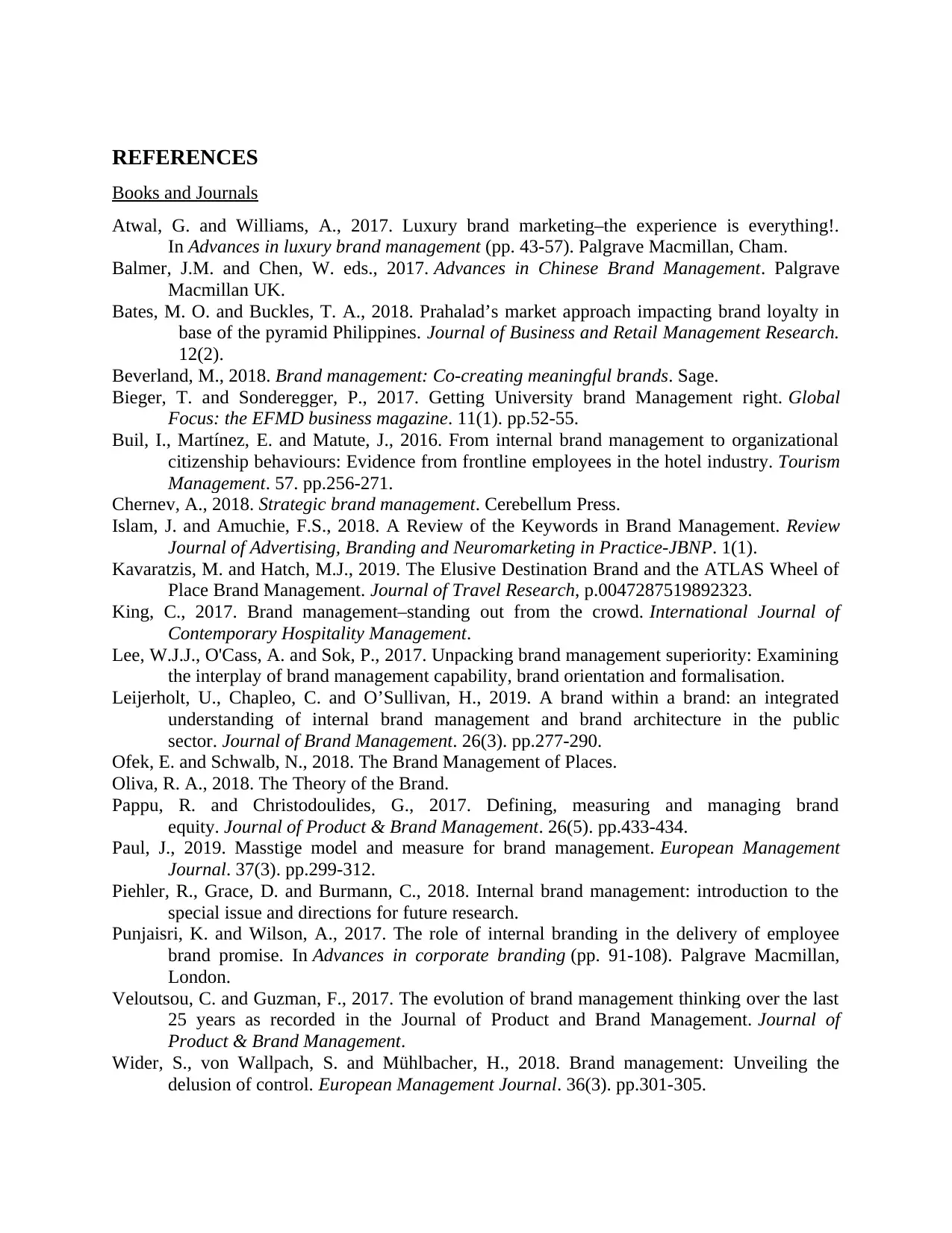
REFERENCES
Books and Journals
Atwal, G. and Williams, A., 2017. Luxury brand marketing–the experience is everything!.
In Advances in luxury brand management (pp. 43-57). Palgrave Macmillan, Cham.
Balmer, J.M. and Chen, W. eds., 2017. Advances in Chinese Brand Management. Palgrave
Macmillan UK.
Bates, M. O. and Buckles, T. A., 2018. Prahalad’s market approach impacting brand loyalty in
base of the pyramid Philippines. Journal of Business and Retail Management Research.
12(2).
Beverland, M., 2018. Brand management: Co-creating meaningful brands. Sage.
Bieger, T. and Sonderegger, P., 2017. Getting University brand Management right. Global
Focus: the EFMD business magazine. 11(1). pp.52-55.
Buil, I., Martínez, E. and Matute, J., 2016. From internal brand management to organizational
citizenship behaviours: Evidence from frontline employees in the hotel industry. Tourism
Management. 57. pp.256-271.
Chernev, A., 2018. Strategic brand management. Cerebellum Press.
Islam, J. and Amuchie, F.S., 2018. A Review of the Keywords in Brand Management. Review
Journal of Advertising, Branding and Neuromarketing in Practice-JBNP. 1(1).
Kavaratzis, M. and Hatch, M.J., 2019. The Elusive Destination Brand and the ATLAS Wheel of
Place Brand Management. Journal of Travel Research, p.0047287519892323.
King, C., 2017. Brand management–standing out from the crowd. International Journal of
Contemporary Hospitality Management.
Lee, W.J.J., O'Cass, A. and Sok, P., 2017. Unpacking brand management superiority: Examining
the interplay of brand management capability, brand orientation and formalisation.
Leijerholt, U., Chapleo, C. and O’Sullivan, H., 2019. A brand within a brand: an integrated
understanding of internal brand management and brand architecture in the public
sector. Journal of Brand Management. 26(3). pp.277-290.
Ofek, E. and Schwalb, N., 2018. The Brand Management of Places.
Oliva, R. A., 2018. The Theory of the Brand.
Pappu, R. and Christodoulides, G., 2017. Defining, measuring and managing brand
equity. Journal of Product & Brand Management. 26(5). pp.433-434.
Paul, J., 2019. Masstige model and measure for brand management. European Management
Journal. 37(3). pp.299-312.
Piehler, R., Grace, D. and Burmann, C., 2018. Internal brand management: introduction to the
special issue and directions for future research.
Punjaisri, K. and Wilson, A., 2017. The role of internal branding in the delivery of employee
brand promise. In Advances in corporate branding (pp. 91-108). Palgrave Macmillan,
London.
Veloutsou, C. and Guzman, F., 2017. The evolution of brand management thinking over the last
25 years as recorded in the Journal of Product and Brand Management. Journal of
Product & Brand Management.
Wider, S., von Wallpach, S. and Mühlbacher, H., 2018. Brand management: Unveiling the
delusion of control. European Management Journal. 36(3). pp.301-305.
Books and Journals
Atwal, G. and Williams, A., 2017. Luxury brand marketing–the experience is everything!.
In Advances in luxury brand management (pp. 43-57). Palgrave Macmillan, Cham.
Balmer, J.M. and Chen, W. eds., 2017. Advances in Chinese Brand Management. Palgrave
Macmillan UK.
Bates, M. O. and Buckles, T. A., 2018. Prahalad’s market approach impacting brand loyalty in
base of the pyramid Philippines. Journal of Business and Retail Management Research.
12(2).
Beverland, M., 2018. Brand management: Co-creating meaningful brands. Sage.
Bieger, T. and Sonderegger, P., 2017. Getting University brand Management right. Global
Focus: the EFMD business magazine. 11(1). pp.52-55.
Buil, I., Martínez, E. and Matute, J., 2016. From internal brand management to organizational
citizenship behaviours: Evidence from frontline employees in the hotel industry. Tourism
Management. 57. pp.256-271.
Chernev, A., 2018. Strategic brand management. Cerebellum Press.
Islam, J. and Amuchie, F.S., 2018. A Review of the Keywords in Brand Management. Review
Journal of Advertising, Branding and Neuromarketing in Practice-JBNP. 1(1).
Kavaratzis, M. and Hatch, M.J., 2019. The Elusive Destination Brand and the ATLAS Wheel of
Place Brand Management. Journal of Travel Research, p.0047287519892323.
King, C., 2017. Brand management–standing out from the crowd. International Journal of
Contemporary Hospitality Management.
Lee, W.J.J., O'Cass, A. and Sok, P., 2017. Unpacking brand management superiority: Examining
the interplay of brand management capability, brand orientation and formalisation.
Leijerholt, U., Chapleo, C. and O’Sullivan, H., 2019. A brand within a brand: an integrated
understanding of internal brand management and brand architecture in the public
sector. Journal of Brand Management. 26(3). pp.277-290.
Ofek, E. and Schwalb, N., 2018. The Brand Management of Places.
Oliva, R. A., 2018. The Theory of the Brand.
Pappu, R. and Christodoulides, G., 2017. Defining, measuring and managing brand
equity. Journal of Product & Brand Management. 26(5). pp.433-434.
Paul, J., 2019. Masstige model and measure for brand management. European Management
Journal. 37(3). pp.299-312.
Piehler, R., Grace, D. and Burmann, C., 2018. Internal brand management: introduction to the
special issue and directions for future research.
Punjaisri, K. and Wilson, A., 2017. The role of internal branding in the delivery of employee
brand promise. In Advances in corporate branding (pp. 91-108). Palgrave Macmillan,
London.
Veloutsou, C. and Guzman, F., 2017. The evolution of brand management thinking over the last
25 years as recorded in the Journal of Product and Brand Management. Journal of
Product & Brand Management.
Wider, S., von Wallpach, S. and Mühlbacher, H., 2018. Brand management: Unveiling the
delusion of control. European Management Journal. 36(3). pp.301-305.

Online
Brand Pyramid. 2019. Online. Available through: <https://knowledge.insead.edu/blog/insead-
blog/how-to-build-a-brand-pyramid-8491>
What is customer- based brand equity? 2020. [Online]. Available through: <
https://www.qualtrics.com/experience-management/brand/customer-based-brand-equity/
>
Brand Pyramid. 2019. Online. Available through: <https://knowledge.insead.edu/blog/insead-
blog/how-to-build-a-brand-pyramid-8491>
What is customer- based brand equity? 2020. [Online]. Available through: <
https://www.qualtrics.com/experience-management/brand/customer-based-brand-equity/
>
1 out of 16
![[object Object]](/_next/static/media/star-bottom.7253800d.svg)





